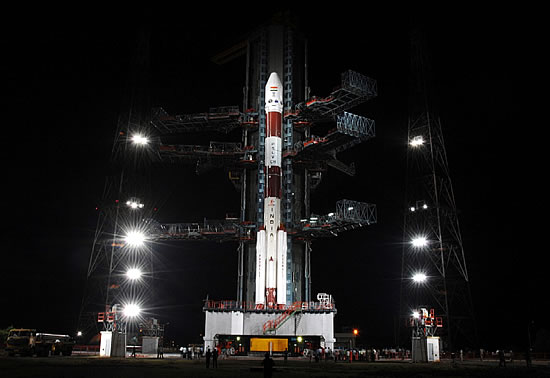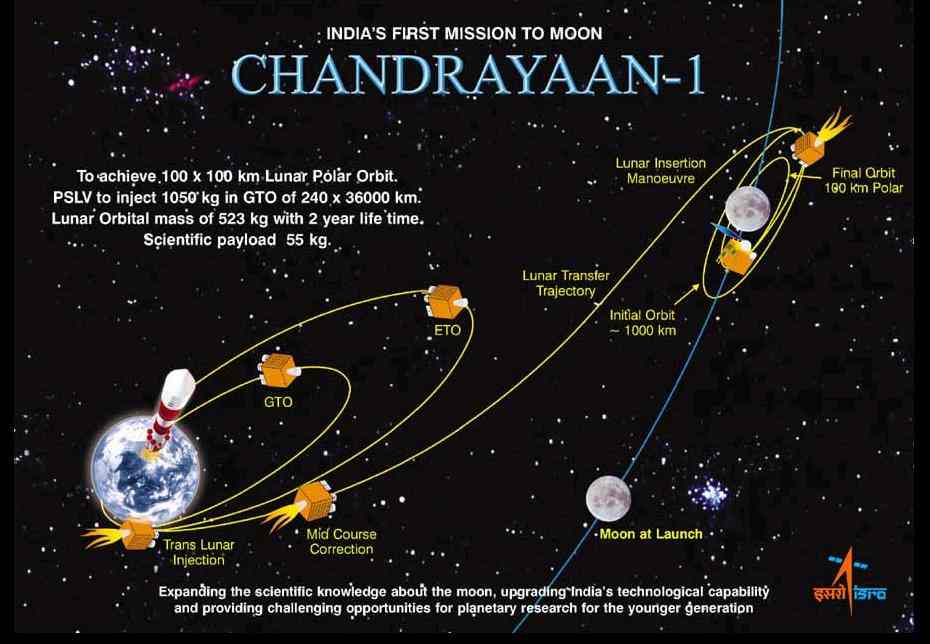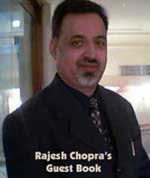India's moon
mission placed in lunar orbit
Nov. 9 India's first
unmanned space probe entered the lunar orbit yesterday and will spend the
next two years mapping the moon's terrain, said the country's space agency.
India became the fifth nation
to send a spacecraft to the moon after the U.S., Russia, Japan and China,
the Indian Space Research Organization said in an e-mailed statement yesterday.
Chandrayaan I, or ``Moon Craft,'' will transmit data to the Indian Deep
Space Network Campus on the outskirts of Bangalore.
The moon is the focus of
international exploration 39 years after American Neil Armstrong became
the first man to walk on its surface. India's $78.9 million mission to
map the moon's terrain is a first step toward landing an unmanned rover
there by 2012.
The path taken by Chandrayaan
I will be reduced in the coming days to achieve a final polar orbit of
about 100 kilometers (62 miles) and a probe will be released to hit the
lunar surface. Close-range images will be taken during the probe's 25-minute
descent, the space agency said.
The spacecraft is also carrying
mapping instruments for the European Space Agency, radiation-measuring
equipment for the Bulgarian Academy of Sciences and two devices for the
National Aeronautics and Space Administration. One of the NASA devices
will look for ice deposits in the lunar poles, while the other will assess
the moon's mineral composition.
India launched its first
rocket in 1963 and its first satellite in 1975. The country's satellite
program consists of 21 orbiters, of which 11 are currently in service,
making it one of the largest communication systems in the world.
Russia is India's main partner
in space programs and has provided manufacturing and design technology.
Most of India's space programs are developed by its own scientists.
India launches Chandrayaan
for moon mission
22 Oct 2008. New Delhi,
Oct 22 (PTI) Parliament today congratulated Indian space scientists on
the successful launch of Chandrayaan-I, the country's maiden mission to
the moon.
As the House met for the
day, Lok Sabha Speaker Somnath Chatterjee lauded the Indian Space Research
Organisation (ISRO) for achieving the landmark of launching a mission to
the moon.
"This historic event marks
India's entry into select band of lunar explorer countries and its growing
stature as an emerging space power," he said.
In the Rajya Sabha, Chairman
Hamid Ansari said the successful launch of Chandrayaan-I was "indeed a
moment of pride" for the country.
Ansari on his behalf and
that of the entire House congratulated ISRO Chairman G Madhavan Nair and
scientists, technicians and all the people associated with the mission.
The House gave a standing
ovation for the achievement.
India scripted a new chapter
in its space programme by launching its maiden moon mission from Satish
Dhawan Space Centre at Sriharikota in Andhra Pradesh at 6:22 a.M. On board
the indigenously built rocket PSLV C-11.
The Lok Sabha also congratulated
the Indian cricket team for its emphatic 320-run win against the visiting
Australian team at Mohali, Punjab yesterday. It is India's biggest-ever
Test victory by runs.
"...It is a matter of great
pride and joy for all of us. Let us compliment the splendid performance
by the Indian team and wish them all success in their ongoing test series
and forthcoming one-day international matches," Chatterjee said. PTI
Sometime earlier today, weather
permitting, a modified version of India’s main Polar Satellite Launch Vehicle
should have lifted off from Sriharikota
spaceport in Andhra Pradesh.
Atop its nosecone it will be ferrying a 575 kg spacecraft called Chandrayaan-1
which, if all goes well, will ultimately orbit the Moon for a period of
about two years.
During that time it will
also release a smaller impact probe to slam into the lunar surface to help
explore it from close range.
But why on earth are we going
to the Moon at all and that too at a cost of nearly Rs 400 crore? Surely
there are other pressing priorities back home like poverty, literacy, medical
care, infrastructure development etc that needs urgent attention and the
taxpayers’ money.
Besides, why are we doing
this now when others have done it several decades ago? The former Soviet
Union and the United States both launched successful lunar orbiting satellites
way back in 1966.
We’re told that, among other
things, the mission will try to source non-radioactive Helium-3 which is
scarce on Earth but believed to be abundant on its natural satellite and
is seen as a promising fuel for advanced fusion reactors in the future.
Once located, we can transport it back from the moon to run nuclear plants
and generate abundant electricity. Apparently, a couple of tonnes of Helium-3
are enough to meet the energy needs of the world. So how come other advanced
nations of the world haven’t thought along similar lines?
They also tell us Chandrayaan
will pave the way for future manned missions to the Moon. But the Americans
have already been there and done that nine times with a flurry of 27 astronauts
between 1968 and 1972 and haven’t gone back since. The Russians, despite
their awesome expertise in space travel, haven’t done it at all.
Obviously it’s either not
that important or no big deal. Or are we missing something here?
We are. It’s the bigger picture
which ultimately involves the colonisation of Moon and Mars. Most everything
else about Chandrayaan — whether it’s a show of strength to demonstrate
that what China does we can too, or to develop terrestrial military missile
options, or benefit from technology spin-offs and generate more jobs and
get young people interested in such science — is, at best, unenduring.
Even the national pride associated with becoming a full member of an elite
club of super space powers, thus announcing India’s place in the world,
is an ephemeral phenomenon.
Earlier this year, the renowned
Cambridge physicist Stephen Hawking had seen this same picture when he
called for a massive investment in establishing colonies on the Moon and
Mars. “If the human race is to continue for another million years”, he
said, “we will have to boldly go where no one has gone before.” Of course,
he also saw it as an insurance policy against the possibility of human
beings being wiped out by catastrophes like nuclear war and climate change.
Ever since humans came out of Africa, exploration has always been in their
blood. Yesterday it was the New World, today it’s Antarctica, tomorrow
the solar system.
This is the real reason why,
after the famously fought face-saving “me first” duel to go to the Moon
in the 1960s, the two original space-faring countries ducked the effort
completely. Instead, what the Russians — and later the Americans — concentrated
on quietly for long decades was in putting its astronauts for longer and
longer periods on the orbiting Mir space station and the International
Space Station (ISS). They wanted to study the effects of weightlessness
on the human body. The information is vital for making long duration journeys
to, say, Mars which can last anything from six to nine months one way.
In fact, besides serving
as a research facility, the whole idea of building space stations is also
for furthering lunar and other interplanetary voyage options. According
to NASA the ISS has a key role to play as it moves forward with a new focus
for its manned space programme, which is to go out beyond the Earth orbit.
The ISS is now a stepping stone. The crews will not only continue to learn
how to live and work in space but also how to build hardware that can survive
and function for the years required to make the round-trip voyage from
Earth to Mars. Is it any surprise then that China too plans on building
one in the future?
|
|
Or that after Chandrayaan-2,
which is scheduled for some time between 2010 and 2012, and a manned mission
to the Moon, ISRO has Mars in its sights? Last year, the principal scientific
investigator to the Chandrayaan mission, J N Goswami, said that scientists
had indeed begun studies about a mission to Mars. And K Kasturirangan,
former ISRO chief, has stated that a mission to Mars by India is a logical
extension to the moon flight.
That’s why Chandrayaan-1
should be heading for the Moon today — because it’s only a matter of time
before humanity starts moving out from Earth. Therefore, it’s good the
country is considering at least some of its priorities to be in outer space
too. It shows that, in the future, India can also be an enduring part of
that outward movement. |
SRIHARIKOTA: After the successful
launch of India's first unmanned mission to moon, Chandrayaan-1, the Indian
Space Research Organisation (ISRO) is p
lanning to send its second
lunar odyssey, Chandrayaan-2, an Indo-Russian joint venture, likely by
the end of next year or early 2010.
The work on this project
would be taken up after Chandrayaan-1 starts its task of researching the
moon, ISRO Chairman G Madhavan Nair told reporters here after the PSLV-C11
launched the spacecraft.
"One of the two GSLV missions
next year could carry Chandrayaan-2," he said.
The team behind the success
of the first mission would work on Chandrayaan-2 also, he added.
However, the composition
of the instruments for Chandrayaan-2 would be decided after studying the
data received from the first mission, he said.
The second mission, for which
the ISRO and Russian federal space agency have already signed a pact, would
feature a lander and a rover for a soft land on moon.
"However, there would be
a provision for accommodating payloads from other space agencies as is
the case of Chandrayaan 1," Nair said.
In addition to India's five
payloads, Chandrayaan-1 is carrying scientific instruments of the European
Space Agency, Bulgaria and the USA.

India launches Chandrayaan
for moon mission
|





